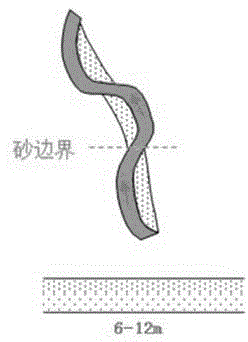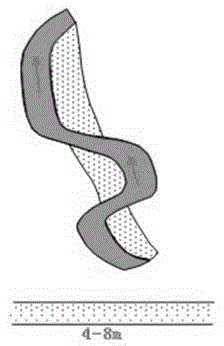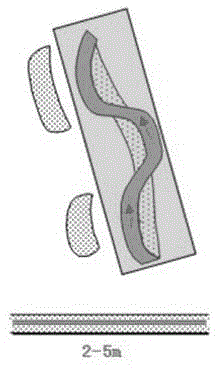Small sand body boundary identification method and small sand body space quantitative description method
A sand body and boundary technology, applied in the field of stratigraphic division and comparison in oilfields, can solve problems such as thin thickness, difficult to describe reservoir boundaries, rapid lateral change of fluvial reservoirs, etc., and achieve the effect of improving prediction accuracy and drilling success rate
- Summary
- Abstract
- Description
- Claims
- Application Information
AI Technical Summary
Problems solved by technology
Method used
Image
Examples
Embodiment 1
[0030] Example 1. A method for identifying the boundary of a small sand body includes the following steps:
[0031] Step 1: Starting from the regional study, relying on the sedimentary characteristics of the adjacent old area, grasp the sand body sedimentation law. Summarize the law and scale of sand body development. Figure 1a to Figure 1d The development model diagrams of different sedimentary microfacies sand bodies are shown. Such as Figure 1a As shown, the low-curved riverside beach develops a narrow band of thick sand; the thick sand is 6-12 meters in thickness and 100-500 meters in width on the low-curved riverside beach, and the length of single sand varies. Such as Figure 1b As shown, the high-curved riverside beach develops a wide band-shaped sand body; it extends mostly 1-3 kilometers, and the width is generally 500-800 meters. It is medium-thick sand with a thickness of 4-8 meters. Such as Figure 1c As shown, the natural dike develops a thinner potato sand body;...
Embodiment 2
[0040] Example 2. A method for spatial quantitative description of small sand bodies, which is characterized in that it comprises the following steps:
[0041] Step 1: Use the small sand body boundary identification method described in Example 1 to describe the sand body boundary and determine the favorable reservoir zone;
[0042] Step 2: Perform a quantitative description of the spatial shape of the sand body through well logging constraint inversion.
[0043] In this embodiment, under the guidance of the study of reservoir deposition law, comprehensive application of seismic event axis tracking, multiwavelet decomposition waveform component analysis, frequency-divided seismic attribute analysis and other technologies are used to determine favorable reservoir zones and describe sand body boundaries. On this basis, through the method of logging constraint inversion, the thickness of the sand body is described in detail, and the spatial shape of the sand body is quantitatively descr...
PUM
 Login to View More
Login to View More Abstract
Description
Claims
Application Information
 Login to View More
Login to View More - R&D
- Intellectual Property
- Life Sciences
- Materials
- Tech Scout
- Unparalleled Data Quality
- Higher Quality Content
- 60% Fewer Hallucinations
Browse by: Latest US Patents, China's latest patents, Technical Efficacy Thesaurus, Application Domain, Technology Topic, Popular Technical Reports.
© 2025 PatSnap. All rights reserved.Legal|Privacy policy|Modern Slavery Act Transparency Statement|Sitemap|About US| Contact US: help@patsnap.com



